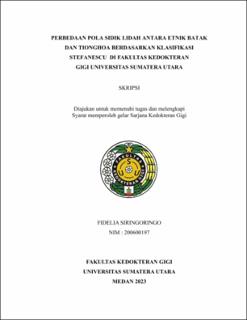| dc.description.abstract | Tongue is an important organ in life and has varying shapes, fissures, textures
and lingual apex. This variation is caused by genetic factors that differ in each
person's gender and ethnicity. Tongue prints are a unique biometric tool and are well
protected from the external environment because they are in the oral cavity.
Objective: to determine and analyze differences in tongue print patterns between
Batak and Chinese ethnic groups based on shape, fissures, texture, lingual apex in
ethnic Batak and Chinese students at the Faculty of Dentistry, University of North
Sumatra. Method: This is a type of descriptive-analytic research with a cross
sectional design, the sample consists of 30 ethnic Batak people (15 women and 15
men) and 30 ethnic Chinese people (15 women and 15 men) at the Faculty of
Dentistry, University of North Sumatra . The tongue is molded using alginate
(irreversible hydrocolloid) material then filled with a type IV cast, and a digital photo
is taken using a professional camera. Tongue print pattern data was analyzed based
on Stefanescu et al's classification, described in percentage values and tabulation
followed by the chi-square statistical test (X2). Results: The differences in patterns in
this study varied. The most common tongue print patterns in Batak ethnic women are
based on shape: V-shape (53.3%), Fissure: Visible (80.0%), Texture: Physiological
(100%), and Lingual apex: Sharp (80.0%) . The most common tongue print patterns
in Batak ethnic males are based on shape: U-shape (46.7%), Fissure: Visible (80.0%),
Texture: Physiological (100%), and Lingual apex: Sharp (73.3 %). The most common
tongue print patterns in ethnic Chinese women are based on shape: Ovoid (60.0%),
Fissure: Visible (86.7%), Texture: Physiological (100%), and Lingual apex: Sharp
(73.3%). The most common tongue print patterns in Chinese ethnic males are based
on shape: Ovoid (53.3%), Fissure: Visible (93.3%), Texture: Physiological (100%),
and Lingual apex: Sharp (80.0%) . Conclusion: There is no significant difference in
tongue print patterns between the two sexes in Batak and Chinese ethnic groups and
there is a significant difference in tongue print patterns between Batak and Chinese
ethnic groups based on aspects of tongue shape (p-value = 0.022 < 0.050) | en_US |





